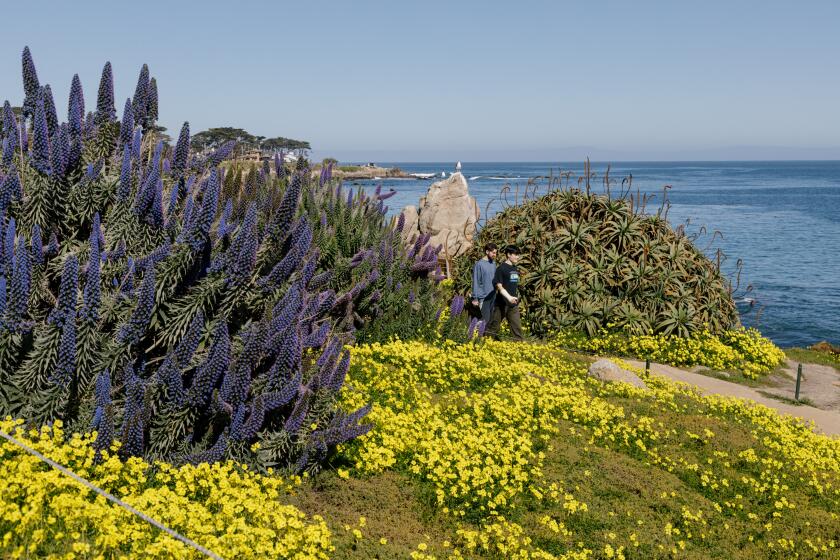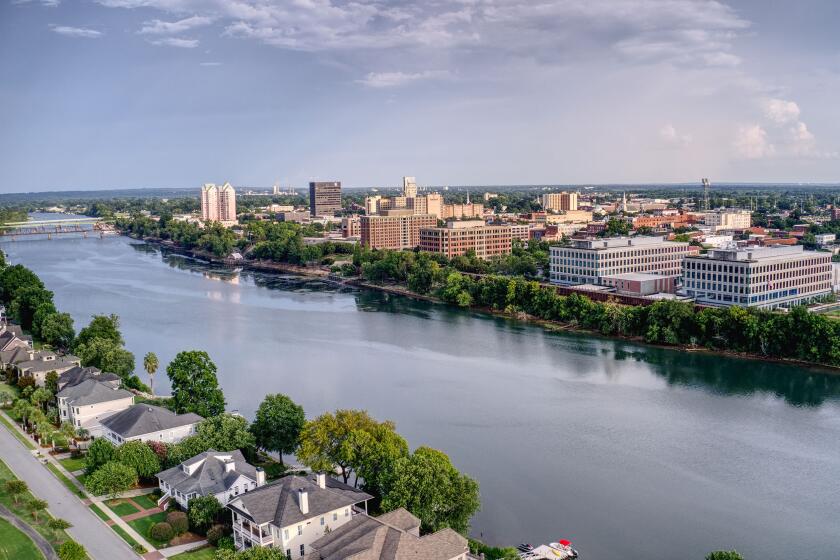Mummies, moai make Chile magical
Soon after exploring sacred sites of the beyond-bizarre Birdman Cult, I found myself again in stony awe. I was on perhaps the remotest inhabited island on Earth — dinky Easter Island — where a gaggle of ancient, far-famed stone-carved huge-headed “moai” statues blankly stared into space, a color-frenzied setting sun turning them supernaturally spectacular. (I was the size of one of their ears.)
If their pursed lips could talk, they’d tell about this isle’s wacky history of tribal warfare, long-fingernailed “Birdman” rulers and maybe cannibalism, but instead they mutely gazed atop stone altars on a grassy coastal plain, their backs to cobalt seas spraying against black lava rocks. To add to the this-can’t-be-real factor, a half-dozen of the island’s many friendly, well-fed stray dogs romped with each other in front of the hallowed megaliths. Then several wild stallions, manes flowing, galloped by; hundreds of horses roam freely among the moai.
Moai and mummies. That’s what yanked me to two vastly different destinations in Chile. Before flying to globally known, Polynesian-flair Easter Island, I traveled to Chile’s little-known most northern city, Arica, to see the world’s oldest mummies and walk over glass atop an unearthed graveyard of an extinct people. In Easter Island, the marquee draw is 887 moai statues who still spellbindingly loom throughout the windswept unspoiled terrain.
This was a journey into two mystery-shrouded cultures. The prehistoric Chinchorro fisherfolk on mainland Chile elaborately mummified every dead soul in their society for reasons unknown. And on Easter Island, Rapa Nui natives between A.D. 1000 and 1600 deified VIP ancestors by chiseling statues up to 33 feet tall and 80 tons and somehow lugging them miles to ceremonial platforms, both brain-boggling feats.
The moai, Easter Island
There’s a mystical pull on this tantalizing South Pacific tropical outpost — it could be from its revered magnetic boulder, the “Navel of the World.” Or because Easter Island, which locals call by its Polynesian name, Rapa Nui, is in the blissful boonies. (To get here, it takes a six-hour, once-daily flight from Chile’s capital, Santiago. Before that, you’ll spend a day flying to Santiago from San Diego.)
Annexed by Chile in 1888, Easter Island — named by Europeans who dropped anchor that holiday in 1722 — is a scene-stealing, 63-square-mile wide-open expanse of Ireland-reminiscent green pastures, rolling hills and occasional cows blocking roads. The only town, funky Hanga Roa, is basically two parallel streets, one abutting the pristine, jagged-cliff coast where you’ll tread past a rustic cemetery adorned by a sculpted wood rooster before coming upon a grouping of moai. A lone sentinel has been restored with peering white coral eyes.
“When the eyes were put in, the moai came alive and had the spiritual power,” my guide Ata said. “They had their backs to the ocean so they could watch over and protect the villages.”
My neck hair rose at the volcanic quarry where nearly 400 moai remain scattered in various stages of completion, just as when, who knows why, they were abandoned by obsessive craftsmen 500 years ago. Like a freaky moai memorial garden, some tiki-ish behemoths are buried by erosion up to their shoulders. Apparently, moai went from representing exalted ancestors to being pure ego trips — an unfinished moai that probably took 20 years of labor measured seven stories. No wonder things turned ugly. The Rapa Nui had deforested the island, and with food and water scarce, clans began warring and possibly eating each other. They knocked down rival tribes’ moai, decapitating statues and gouging out the all-potent eyes.
Enter the Birdman Cult. Yep, this lost civilization gets kookier. To stop the killing and choose a ruler, each clan picked a competitor who raced each other to find the season’s first sooty tern egg. “They had to jump off a steep cliff and then swim in shark-infested waters. Many died,” said our guide. We were looking out from the cult’s petroglyph-adorned Orongo ceremonial village to the islet where the winner strapped the egg in a tiny basket around his forehead before swimming back. His patron became the Birdman; to look the part, that guy shaved his head and grew his fingernails to mimic claws.
The next day, we were bowled over by the blockbuster — Ahu Tongariki’s 15 furrowed-brow, volcanic-gray, tsunami-surviving rock stars backlit by a brilliant blue sky (one moai oddly resembled Richard Nixon). As if this island hadn’t already possessed me, when I returned that night to the energy-ooming Hangaroa Eco Village & Spa — it is styled after the Birdman Cult’s stone ceremonial village — I ran into three chestnut-colored wild horses trotting past the moonlit pool. You can’t begin to dream this stuff up.
The mummies, Arica
I’m mesmerized by mummies. So before Easter Island, I journeyed to an authentic region of Chile near Bolivia and Peru and gazed at archaeological A-listers — clay-coated 7,000-year-old beings, some with open mouths reminiscent of Edvard Munch’s acclaimed painting “The Scream.” The mummies of South America’s Chinchorro culture — up for UNESCO World Heritage consideration — are the oldest on Earth, predating the Egyptians by 2,000 years, and so insanely intricate they’re considered mortician works of art. In the laid-back coastal city of Arica, mummies have been dug up all over the place.
What makes them so significant is that the Chinchorro sophisticatedly prepared everyone, including miscarried fetuses, for their afterlife (the Egyptians only mummified kings and the elite). And what a process — as far back as 5000 B.C., the Chinchorro removed the dearly departed’s brains and organs, stuffed their insides with grass, ash and animal hair, used sticks to strengthen the body, delicately reattached their skin, affixed a wig of human hair, applied a clay paste and painted the body black. You can see 120 mummies (some parts so preserved, fleshy fingers are intact) at the University of Tarapaca’s well-designed Museo Arqueologico. Scholars suggest the mummies may have been worshipped as ancestors or displayed by relatives who interacted with them.
Elsewhere in town, I walked on a glass floor over the remains of 32 Chinchorro men, women and babies lying in dirt in their graveyard. Items to be used in the hereafter, such as vegetable fiber mats, shell fishing hooks and seabird feathers, accompanied them. The millenniums-old mummies, many rotted to skeletons, were discovered in 2004 when a colonial house was being excavated for a hotel. Too fragile to be moved, they now comprise the university’s Museo de Sitio Colon 10.
To see more of Chile (sans mummies), I’d adventure out from Arica, traveling hours by car on dusty, two-lane Highway 11 through arid landscapes dotted with llamas, alpacas, camel-like vicuñas, rare “candelabra cactus” and sleepy Andean villages. I gasped (14,820 feet altitude!) at the beauty of Lake Chungara, ringed by majestic snow-capped volcanoes reflected in mirrored waters. A perfect respite before jetting to enigmatic Easter Island and pondering if multi-ton moai could’ve “walked” to their anointed spots.
If you go
Easter Island logistics: You have to first fly to Santiago (various carriers). From there, only LAN Airlines flies to Easter Island, www.lan.com.
Lodging laurels: Hangaroa Eco Village & Spa is Easter Island’s upscale low-slung grass-roofed oceanview hotel that reflects Rapa Nui culture with a cool earthy vibe. Suites have cypress tree trunks vaulting to the ceiling, hand-sculpted clay bathtubs, volcanic-rock sinks, invisible rest-promoting “bands” around beds to minimize electromagnetic fields and traditional pine-stick fences on private terraces to protect guests’ energy. Plus the staff is super nice. www.hangaroa.cl
Chinchorro mummies: Click the English translation flag on www.momiaschinchorro.cl
Learn more: Chile’s official tourism site offers info about Arica, lodging and lots more, chile.travel/en.
Get U-T Arts & Culture on Thursdays
A San Diego insider’s look at what talented artists are bringing to the stage, screen, galleries and more.
You may occasionally receive promotional content from the San Diego Union-Tribune.





